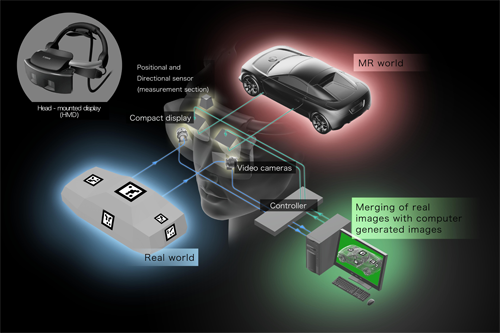Canon has shown off more details with its 3D take on augmented reality. It looks like an impressive but expensive technology that might be a solution in search of a problem.
The system is dubbed MREAL, standing for Mixed Reality, and goes on sale on March 1. It’s the same basic concept as augmented reality, which uses a screen or glasses to overlay graphics or text on a picture of the real world.
The MREAL system uses a headset with two cameras placed directly in front of the eyes to capture what the user would see without the equipment. It then combines these images to make a 3D picture, adds on the computer generated material, and then produces a 3D image shown to the user on a screen that lies between the cameras and their eyes.
According to Canon, the resulting part-real, part-fake image is a “unique three-sided configuration that produces clear, solid-looking images with low distortion, reducing the impact of optical aberrations, even in peripheral areas, and further enhances the realism of the experience.”
Sounds great, but what can you do with it? Well, Canon has a few suggestions, the first being that automakers could use it to show off luxury cars in a lot without the vehicle having to be there. Instead of looking at a brochure or a video, the customer could look at what appeared to be a life-size 3D representation of the vehicle. Theoretically they could even see how customization options would look, something that you can’t easily do with a real vehicle.
It could also work for designers, for example allowing customers to see what a particular piece of furniture would look like in their kitchen.
Another suggestion is for medical use with patients who need long term rehabilitation and care in a medical facility, particularly with neurological issues. The idea is that the patient could wear the headset and at least simulate the experience of being in their own home.
Canon didn’t mention any of the seemingly obvious uses that aren’t so in keeping with its corporate image, but chances are somebody is already figuring out how to build a virtual lap-dancing service for horny folks who aren’t allowed to leave their basement. That might prove an economic challenge though: the downside is that the headset and accompanying hardware and software costs $125,000 and carries a $25,000 maintenance fee.

